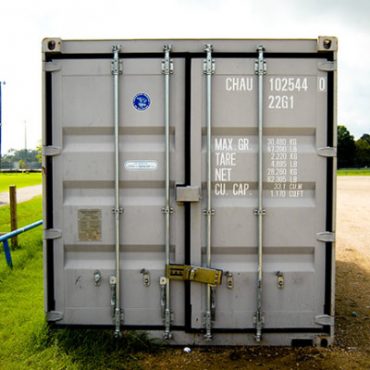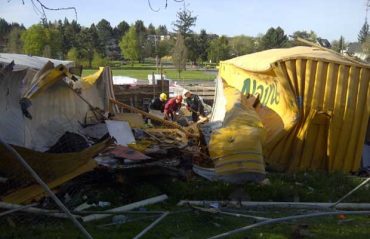
John Bleasby
Recycled shipping containers a work-site hazard? Who knew?
Canadian ContractorHandy for storage and shelter, old shipping containers are not risk-free structures
Recycled shipping containers appear on construction sites like spring flowers. Their modified uses are as varied as their colors: storage, weather shelter, change or first aid rooms, and toilet facilities. You can rent them short term, or purchase them outright for less than a couple of thousand dollars depending on size and condition and move them from site to site. Solidly built and designed to be stacked on freighters, containers have big barn-like doors that can be securely locked, or with some ingenuity be turned into almost permanent office structures with the addition of regular windows and doors.
Yet as ubiquitous as they might be, old shipping containers are not risk free. Using them for almost every purpose other than what they were designed for presents issues that smart and safety-conscious contractors need to consider.

Container doors (250 lbs each) can become lethal projectiles in cases of a explosion from fire
WorkSafeBC recently published comments from Andrew Lim, Senior regional instructor, Learning and Development Services Region in Richmond BC. Lim points some of the hazards and makes suggestions regarding mitigating them. “One of the biggest hazards is the potential for explosions,” says Lim. “Shipping containers have the potential to become a pressurized bomb if they contain enough of the three elements of the ‘fire triangle’ (oxygen, fuel, and a heat source). Storing even small amounts of flammable liquids or combustible gases can forcibly rupture containers. For example, 1 kilogram of propane is enough to cause an explosion that will forcibly rupture a shipping container. By comparison, your home barbecue uses a 9-kilogram propane tank.”
Fumes can build up inside containers when the doors are closed due to the poor ventilation. Containers typically have only nine holes between six and nine millimetres each that act as heat and cold expansion equalizers in changing weather. That is not enough to properly ventilate any vapours trapped inside. Lim cites the tragic case where a firefighter in Enderby, BC was struck and killed in 2011 when a 250-lb. door blew off a container in an explosion. The force of the blast caused the door to fly over 120 feet away.

A container fire or explosion can have catastrophic effects to nearby workers or firefighters
In addition, recycled containers are just that, recycled, and their previous use on other sites or during shipping from overseas is a guess. All sorts of pesticides and contaminants may be embedded in the wooden floors (usually made from tropical woods) or on the walls and ceiling, often sprayed to prevent bugs during shipment. And since containers are made of steel, they can turn into giant electrical conductors if not properly wired and grounded.
Lim suggest contractors check to see if any of the flowing steps have been taken before either renting or purchasing a used shipping container for use on their site.
1. Check for adequate ventilation.
2. Don’t store combustibles like fuel and propane in the same container as any potential ignition sources.
3. Know the contents of your container and list them on your Fire Plan so firefighters are informed in case of an incident.
4.Replace the floor with clean, painted plywood or planks.
5. Consider weakening the structure to allow for earlier structural failure. Containers are far stronger than they need to be for construction site purposes. The high pressures that can build up turn doors into lethal projectiles.
Given the absence of any national standards, provinces across Canada are themselves starting to recognize the increased use of shipping containers as building structures and are regulating them as such. Saskatchewan and Ontario, for example, consider containers as buildings under their respective building standards or building codes, even if the placement on a site or property is temporary. On the other hand, British Columbia only considers containers buildings if placed on a foundation and modified with windows, doors and electrical services. Best to check what regulations apply in your jurisdiction.
No matter the regulations, the precautions suggested by Andrew Lim are words for the wise contractor, anywhere in Canada.
Follow John on Instagram and on Twitter for notifications about our newest posts



Leave a Reply